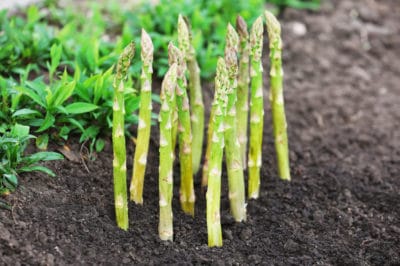How to Plant Asparagus Crowns
Purchase asparagus crowns from a nursery or online, or grow them from seed a year earlier. You can also sow the seeds directly in the garden and let the crowns grow in place.
Prepare an asparagus bed, giving approximately 2 square feet (.19 square meters) for each crown. Dig trenches 3 to 4 feet (.9 to 1.2 meters) apart, making the trenches approximately 16 inches (40cm) wide and 6 to 8 inches (15 to 20cm) deep.
Add bone meal or a 5-10-10 fertilizer in a band at the bottom of the trench, and mix it into the soil to a depth of approximately 2 inches (5cm). Then place the asparagus crowns at the bottom of the trench, spreading out the roots around the central crown, and making sure the bud side of the crown is facing upward.
If you have light, sandy soil, plant the crowns at a depth of approximately 8 inches (20cm). If your soil is heavy clay, plant them at a depth of 6 inches (15cm). Cover the crowns with soil, filling the trench to about 1 inch (2.5cm) below the top.
Alternately, some people prefer to cover the crowns with 2 inches (5cm) of soil at planting, and then fill in the trench over the crown as it grows. However, research studies have found no significant difference between the two planting methods.
Caring for Asparagus After Planting
- Harvest the plants only after they grow for two full years, and harvest lightly in the first year.
- Fertilize the plants each spring for the first three years and in July after the shoots are picked when plants are over three years old.
- Irrigate the plants after planting and regularly while the ferns are growing. Taper off irrigation in the fall after ferns die-back, and water occasionally in winter if there is no rain.
- Weed plants as needed, but take care not to disturb the shallow roots by digging too deeply.
- Cut back the ferns at the end of the growing season and mulch the bed for the winter.
Choosing Cultivars for Production
Asparagus produces males and females on separate plants. Female asparagus plants spend more resources on producing berries and seeds at the expense of harvestable shoots.
When planting asparagus, you can choose cultivars with all male plants, a mix, or all female. If you are growing for maximum production of edible shoots, look for crowns of all-male cultivars such as Jersey King, Jersey Supreme, Jersey Knight, and Jersey Giant.
